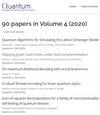Benchmarking a trapped-ion quantum computer with 30 qubits
IF 5.1
2区 物理与天体物理
Q1 PHYSICS, MULTIDISCIPLINARY
引用次数: 0
Abstract
Quantum computers are rapidly becoming more capable, with dramatic increases in both qubit count [1] and quality [2]. Among different hardware approaches, trapped-ion quantum processors are a leading technology for quantum computing, with established high-fidelity operations and architectures with promising scaling. Here, we demonstrate and thoroughly benchmark the IonQ Forte system: configured as a single-chain 30-qubit trapped-ion quantum computer with all-to-all operations. We assess the performance of our quantum computer operation at the component level via direct randomized benchmarking (DRB) across all 30 choose 2 = 435 gate pairs. We then show the results of application-oriented [3][4] benchmarks and show that the system passes the suite of algorithmic qubit (AQ) benchmarks up to #AQ 29. Finally, we use our component-level benchmarking to build a system-level model to predict the application benchmarking data through direct simulation. While we find that the system-level model correlates with the experiment in predicting application circuit performance, we note quantitative discrepancies indicating significant out-of-model errors, leading to higher predicted performance than what is observed. This highlights that as quantum computers move toward larger and higher-quality devices, characterization becomes more challenging, suggesting future work required to push performance further.30 量子位困离子量子计算机的基准测试
随着量子比特数量[1]和质量[2]的大幅提升,量子计算机的能力正在迅速增强。在不同的硬件方法中,困离子量子处理器是量子计算的领先技术,它具有成熟的高保真操作和可扩展的架构。在这里,我们展示了 IonQ Forte 系统,并对其进行了全面的基准测试:该系统配置为单链 30 量子比特困离子量子计算机,可进行全对全操作。我们通过对所有 30 选 2 = 435 门对进行直接随机基准测试(DRB),在组件层面评估量子计算机的运行性能。然后,我们展示了面向应用[3][4]的基准测试结果,并表明该系统通过了算法量子位(AQ)基准测试,最高可达 #AQ 29。最后,我们利用组件级基准测试建立了一个系统级模型,通过直接模拟来预测应用基准测试数据。虽然我们发现系统级模型在预测应用电路性能方面与实验结果相关,但我们注意到数量上的差异,这表明模型外误差很大,导致预测性能高于观察性能。这突出表明,随着量子计算机向更大型、更高质量的器件发展,表征工作变得更具挑战性,这也是未来进一步提升性能所需的工作。
本文章由计算机程序翻译,如有差异,请以英文原文为准。
求助全文
约1分钟内获得全文
求助全文
来源期刊

Quantum
Physics and Astronomy-Physics and Astronomy (miscellaneous)
CiteScore
9.20
自引率
10.90%
发文量
241
审稿时长
16 weeks
期刊介绍:
Quantum is an open-access peer-reviewed journal for quantum science and related fields. Quantum is non-profit and community-run: an effort by researchers and for researchers to make science more open and publishing more transparent and efficient.
 求助内容:
求助内容: 应助结果提醒方式:
应助结果提醒方式:


